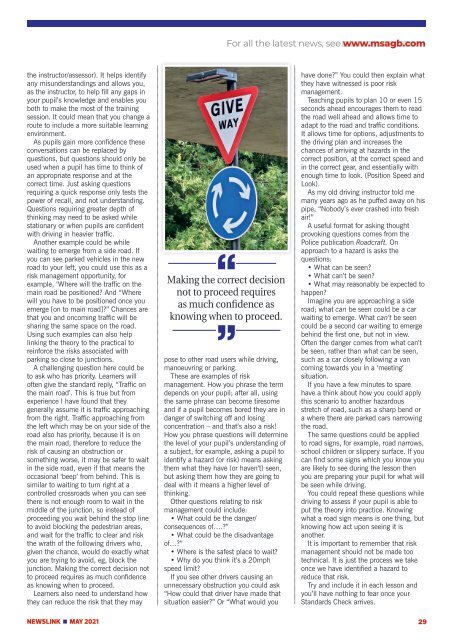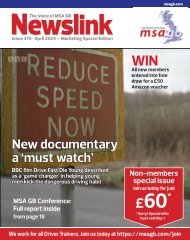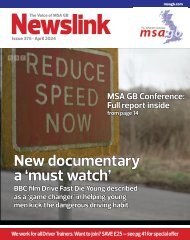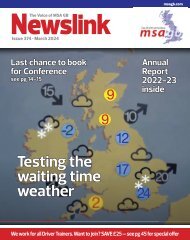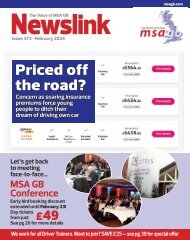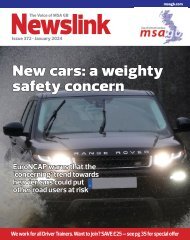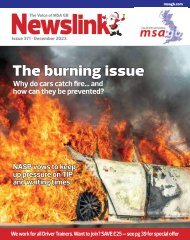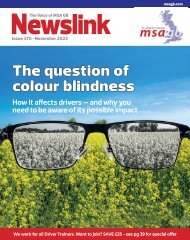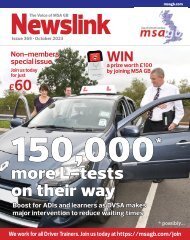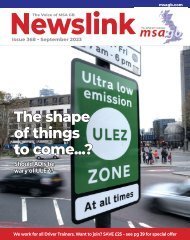Newslink May
Motor Schools Association of Great Britain, driving instructors, ADIs, road safety
Motor Schools Association of Great Britain, driving instructors, ADIs, road safety
You also want an ePaper? Increase the reach of your titles
YUMPU automatically turns print PDFs into web optimized ePapers that Google loves.
For all the latest news, see www.msagb.com<br />
the instructor/assessor). It helps identify<br />
any misunderstandings and allows you,<br />
as the instructor, to help fill any gaps in<br />
your pupil’s knowledge and enables you<br />
both to make the most of the training<br />
session. It could mean that you change a<br />
route to include a more suitable learning<br />
environment.<br />
As pupils gain more confidence these<br />
conversations can be replaced by<br />
questions, but questions should only be<br />
used when a pupil has time to think of<br />
an appropriate response and at the<br />
correct time. Just asking questions<br />
requiring a quick response only tests the<br />
power of recall, and not understanding.<br />
Questions requiring greater depth of<br />
thinking may need to be asked while<br />
stationary or when pupils are confident<br />
with driving in heavier traffic.<br />
Another example could be while<br />
waiting to emerge from a side road. If<br />
you can see parked vehicles in the new<br />
road to your left, you could use this as a<br />
risk management opportunity, for<br />
example, ‘Where will the traffic on the<br />
main road be positioned? And “Where<br />
will you have to be positioned once you<br />
emerge [on to main road]?” Chances are<br />
that you and oncoming traffic will be<br />
sharing the same space on the road.<br />
Using such examples can also help<br />
linking the theory to the practical to<br />
reinforce the risks associated with<br />
parking so close to junctions.<br />
A challenging question here could be<br />
to ask who has priority. Learners will<br />
often give the standard reply, “Traffic on<br />
the main road’. This is true but from<br />
experience I have found that they<br />
generally assume it is traffic approaching<br />
from the right. Traffic approaching from<br />
the left which may be on your side of the<br />
road also has priority, because it is on<br />
the main road, therefore to reduce the<br />
risk of causing an obstruction or<br />
something worse, it may be safer to wait<br />
in the side road, even if that means the<br />
occasional ‘beep’ from behind. This is<br />
similar to waiting to turn right at a<br />
controlled crossroads when you can see<br />
there is not enough room to wait in the<br />
middle of the junction, so instead of<br />
proceeding you wait behind the stop line<br />
to avoid blocking the pedestrian areas,<br />
and wait for the traffic to clear and risk<br />
the wrath of the following drivers who,<br />
given the chance, would do exactly what<br />
you are trying to avoid, eg, block the<br />
junction. Making the correct decision not<br />
to proceed requires as much confidence<br />
as knowing when to proceed.<br />
Learners also need to understand how<br />
they can reduce the risk that they may<br />
‘‘<br />
Making the correct decision<br />
not to proceed requires<br />
as much confidence as<br />
knowing when to proceed.<br />
‘‘<br />
pose to other road users while driving,<br />
manoeuvring or parking.<br />
These are examples of risk<br />
management. How you phrase the term<br />
depends on your pupil; after all, using<br />
the same phrase can become tiresome<br />
and if a pupil becomes bored they are in<br />
danger of switching off and losing<br />
concentration – and that’s also a risk!<br />
How you phrase questions will determine<br />
the level of your pupil’s understanding of<br />
a subject, for example, asking a pupil to<br />
identify a hazard (or risk) means asking<br />
them what they have (or haven’t) seen,<br />
but asking them how they are going to<br />
deal with it means a higher level of<br />
thinking.<br />
Other questions relating to risk<br />
management could include:<br />
• What could be the danger/<br />
consequences of….?”<br />
• What could be the disadvantage<br />
of…?”<br />
• Where is the safest place to wait?<br />
• Why do you think it’s a 20mph<br />
speed limit?<br />
If you see other drivers causing an<br />
unnecessary obstruction you could ask<br />
“How could that driver have made that<br />
situation easier?” Or “What would you<br />
have done?” You could then explain what<br />
they have witnessed is poor risk<br />
management.<br />
Teaching pupils to plan 10 or even 15<br />
seconds ahead encourages them to read<br />
the road well ahead and allows time to<br />
adapt to the road and traffic conditions.<br />
It allows time for options, adjustments to<br />
the driving plan and increases the<br />
chances of arriving at hazards in the<br />
correct position, at the correct speed and<br />
in the correct gear, and essentially with<br />
enough time to look. (Position Speed and<br />
Look).<br />
As my old driving instructor told me<br />
many years ago as he puffed away on his<br />
pipe, “Nobody’s ever crashed into fresh<br />
air!”<br />
A useful format for asking thought<br />
provoking questions comes from the<br />
Police publication Roadcraft. On<br />
approach to a hazard is asks the<br />
questions:<br />
• What can be seen?<br />
• What can’t be seen?<br />
• What may reasonably be expected to<br />
happen?<br />
Imagine you are approaching a side<br />
road; what can be seen could be a car<br />
waiting to emerge. What can’t be seen<br />
could be a second car waiting to emerge<br />
behind the first one, but not in view.<br />
Often the danger comes from what can’t<br />
be seen, rather than what can be seen,<br />
such as a car closely following a van<br />
coming towards you in a ‘meeting’<br />
situation.<br />
If you have a few minutes to spare<br />
have a think about how you could apply<br />
this scenario to another hazardous<br />
stretch of road, such as a sharp bend or<br />
a where there are parked cars narrowing<br />
the road.<br />
The same questions could be applied<br />
to road signs, for example, road narrows,<br />
school children or slippery surface. If you<br />
can find some signs which you know you<br />
are likely to see during the lesson then<br />
you are preparing your pupil for what will<br />
be seen while driving.<br />
You could repeat these questions while<br />
driving to assess if your pupil is able to<br />
put the theory into practice. Knowing<br />
what a road sign means is one thing, but<br />
knowing how act upon seeing it is<br />
another.<br />
It is important to remember that risk<br />
management should not be made too<br />
technical. It is just the process we take<br />
once we have identified a hazard to<br />
reduce that risk.<br />
Try and include it in each lesson and<br />
you’ll have nothing to fear once your<br />
Standards Check arrives.<br />
NEWSLINK n MAY 2021<br />
29


